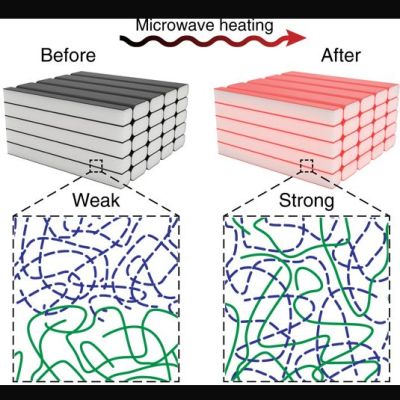
Layer adhesion is one of the weak points with FDM 3D printing, with annealing often recommended as a post-processing step. An interestingly creative method for this was published in Science Advances back in 2017, featuring the work of researchers at Texas A&M University and citing previous work by other teams. In the paper by [Charles B. Sweeney] et al, they describe how they coated PLA filament with carbon nanotubes (CNTs), resulting in this CNT being distributed primarily between the individual layers of polymer.
This is useful because CNTs are quite sensitive to microwave radiation, resulting in the conversion to thermal energy, i.e. heat. Compared to traditional annealing where the entire part is placed into an oven or similar, this microwave-based heating – or locally induced RF (LIRF) as they call this method – localizes the heat to the interface between two layers.
The advantages of this approach are that it doesn’t change the dimensions of the part noticeably, it’s faster and more efficient, and the annealing between layers approaches the strength of traditional manufacturing. Unfortunately not too much seems to have happened with this approach since then, but considering that both CNTs (single & double-walled) and microwaves are readily available, there’s not much standing in the way of replicating these results.
















OR, place a layer of superglue between each layer (use screw-on plastic nozzles on a separate controlled extruder)
remelting just the adhesion layer looks awesome… I do wonder if there are cheaper/easier alternative than CNT for that through…
Very fine graphite powder and cotton buffing wheels would be my first attempt.
I wonder if making a hopper that the filament goes through first would deposit enough graphite on to the filament. That would be an interesting experiment
If this did work, I wonder if it would improve the strength of offset layer height prints.
I also wonder if it would improve flow rates, since graphite can be used a lubricant.
Not sure that is a good idea. Wouldn’t a layer of that mess with the melt and adhesion. What’s the temperature stability of cyanoacrylate?
that is a good point for investigation!
I guess that would be one way to make sure your prints stick really well to the bed. 😂
I am pretty sure in long term superglue cannot be better than two pieces of same plastic properly melted/welded together. Also have fun geting your nozzle(s) cloged by superglue..
Wondering what the health implications of pervasive carbon nanotubes might be … A bit like asbestos, perhaps? Do they break down naturally outside the body, what happens if they enter the body, etc?
Good point. Around here PFAS is in the news very often. Per- and polyfluoroalkyl substances (PFAS), also known as “forever chemicals” due to their persistence in the environment, have become a significant concern. These synthetic compounds are utilized in various products, including non-stick cookware, waterproof clothing, and cosmetics. Their resistance to degradation has led to widespread environmental contamination and potential health risks. Recent analyses have revealed that numerous rivers, lakes, and coastal waters contain PFAS concentrations exceeding European Union (EU) legal limits. This contamination is attributed to the extensive use of PFAS in various industries and consumer products. 
Best to be careful with other (close to) forever materials until we understand the implications. There is no such thing as a free lunch.
I’ll keep baking packed in flour salt.
This is the correct take-away for us makers. But I guess there might be some companies that might want something less human-in-the-loopy
Or us makers could use the time saved by microwaving to, say, make other stuff?
It’s probably too much to hope that the same can be said for regular ol’ CF-filled filaments, eh?
That wouldn’t be the point.
The point is that the microwave only heats the boundary between layers.
If it heats the whole thing, you just melt the print.
@Maya we actually did a lot more work on this. Check out our follow up research here: https://pubs.acs.org/doi/10.1021/acs.nanolett.9b04718
This technology was commercialized by our spin off startup company called Essentium as our FlashFuse technology. Thanks for covering the research!
CNTs are amazing.
They are also a bad solution outside of lab conditions.
CNTs is a NASTY material to work with, and having it wear away and get onto surfaces or into the air is quite bad.
Once it makes it into some mainstream products, it is only a matter of time until the inevitable health problems gets it restricted/banned…
I had a professor back in my Ga Tech days who did some RF consulting in industry, and one of the projects he worked on was using high power RF to dry sheetrock in the manufacturing process.
For the sake of the acronym we should be glad they’re not copper nanotubes.